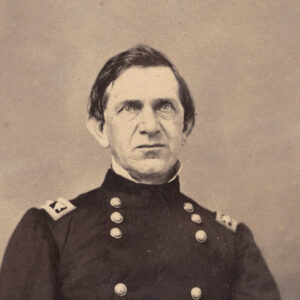calsfoundation@cals.org
Operations on the White River and Attack on the Clara Bell (July 19–25, 1864)
The Union army undertook the operations on the White River in late July 1864 to protect the lines of communication between the Mississippi River and Major General Frederick Steele’s headquarters in Little Rock (Pulaski County) as Confederate brigadier general Joseph O. Shelby’s troops rampaged through eastern Arkansas.
Shelby and his men crossed the Arkansas River in May 1864 and began operations behind Union lines, including a June attack in Clarendon (Monroe County) in which they captured and sank the USS Queen City on the White River. On June 22, some 300 Confederates under Colonel Robert Lawther attacked Captain J. R. C. Hunter’s fifty-man command from the Twelfth Iowa Infantry in their camp at the mouth of the White, retreating under fire from the gunboat USS Lexington.
This left Union officials fearing that Shelby would disrupt Steele’s line of communications along the White, and Major General E. R. S. Canby on July 11 ordered Brigadier General Albert L. Lee to bring his infantry brigade and the Seventh Massachusetts and Twenty-sixth New York Artillery Batteries from Morganza, Louisiana, to the mouth of the White River, where Brigadier General George H. Gordon would take command. Brevet Brigadier General Joseph Bailey was ordered to have his brigade in Vicksburg, Mississippi, ready to reinforce Gordon if needed.
Gordon arrived at the mouth of the White on July 19 and the next day ordered Bailey to head to Arkansas with his Engineer Brigade. Gordon and his command headed up the White River on July 21 and arrived two days later at St. Charles (Arkansas County), where they occupied and improved entrenchments already established there. Bailey left Vicksburg on July 23, though four companies of the Sixth Michigan Heavy Artillery were left behind awaiting transport; Bailey arrived on July 25.
The 400 men of the Sixth Michigan headed upriver on July 24 aboard the steamboat Clara Bell, a sidewheel paddleboat built at Louisville, Kentucky, in 1860. When it was near the Louisiana-Arkansas state line on the Mississippi River, a Confederate battery opened fire from the Arkansas side, striking the Clara Bell thirty times and wounding thirteen of the Michigan soldiers. The vessel steamed to Carbine Landing, Mississippi, to make emergency repairs, but Confederate artillery opened fire again, setting the Clara Bell ablaze with an exploding shell and burning it to the water line. The Federal troops marched eight miles to Skipworth’s Landing, where the steamboat Levia picked them up the next day and brought them to link up with Gordon.
The large force of Union soldiers on the White River was soon ordered elsewhere to replace troops sent east to fight with the Army of the Potomac, and by August 1 the garrison at the mouth of the White once again consisted of the fifty men from the Twelfth Iowa, reinforced by an understrength company of the Sixth Michigan Infantry.
For additional information:
Hewett, Janet B., et al., eds. Supplement to the Official Records of the Union and Confederate Armies, Vol. 30. Wilmington, NC: Broadfoot Publishing Co., 1996.
The War of the Rebellion: A Compilation of the Official Records of the Union and Confederate Armies, Series I, Vol. 41, part 1, pp. 87–88; part 2, pp. 121, 349–350, 500–501. Washington DC: Government Printing Office, 1893.
Way, Frederick, Jr. Way’s Packet Directory. Athens: Ohio University Press, 1983.
Mark K. Christ
Central Arkansas Library System
 Civil War Timeline
Civil War Timeline Military
Military Edward R. S. Canby
Edward R. S. Canby 




Comments
No comments on this entry yet.